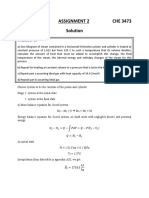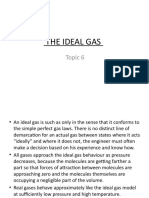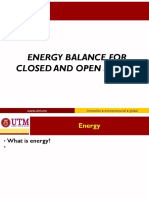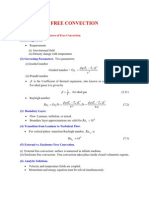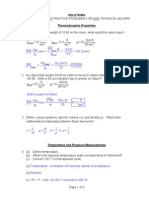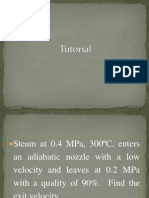Perfect Gases
Perfect Gases
Uploaded by
ellayuslianaCopyright:
Available Formats
Perfect Gases
Perfect Gases
Uploaded by
ellayuslianaOriginal Description:
Copyright
Available Formats
Share this document
Did you find this document useful?
Is this content inappropriate?
Copyright:
Available Formats
Perfect Gases
Perfect Gases
Uploaded by
ellayuslianaCopyright:
Available Formats
Alteration of combined gas law
Ideal gas law calculates the number of moles
of a gas in a fixed volume at a known
temperature and pressure
Relates Pressure, Volume, &
Temperature.
SI units for these properties are
Pascal(Pa) for pressure, m
3
for volume
and Kelvin(K) for temperature.
Two of the laws describing the behavior of
a perfect gas are:
Boyles Law = Constant T
Charless Law = Constant P
Boyles Law
P o 1/V
P x V = constant
P
1
x V
1
= P
2
x V
2
Example 2.1
Solution to Example 2.1
From equation P
1
V
1
= P
2
V
2
A quantity of a certain perfect gas is heated at a
constant temperature from an initial state of 0.22
m
3
and
325 kN/m
2
to a final state of 170 kN/m
2
.
Calculate the final volume of the gas.
( )
3
2
2
3
2
1
1 2
m 0.421
kN/m 170
kN/m 325
m 0.22 x =
|
|
.
|
\
|
= =
P
P
V V
Charles Law
AS TEMPERATURE GOES UP, VOLUME GOES
UP (DIRECT)
CHARLES LAW SAYS:
VOLUMES 1 AND 2 MUST BE THE SAME
UNITS
TEMPERATURES 1 AND 2 MUST BE IN KELVIN
V
1
V
2
T
1
T
2
=
V o T
Example 2.2
From the question
V1 = 0.54 m3
T1 = 345 + 273 K = 618 K
V2 = 0.32 m3
A quantity of gas at 0.54 m
3
and 345
o
C undergoes a constant
pressure process that causes the volume of the gas to
decreases to 0.32 m
3
. Calculate the temperature of the gas at
the end of the process.
( )
K 366
m 0.54
m 0.32
K 618
x
3
3
1
2
1 2
2
2
1
1
=
|
|
.
|
\
|
=
=
=
V
V
T T
T
V
T
V
Universal Gases Law
The relation which gives the volume of a gas when both
temperature and the pressure are changed is stated as
equation below.
R
T
PV
= = constant
2
2 2
1
1 1
T
V P
T
V P
=
Characteristic equation of
state of a perfect gas
The constant, R, is called the gas constant. The unit of
R is Nm/kg K or J/kg K. Each perfect gas has a different
gas constant.
The characteristic equation is usually written
PV = RT
or for m kg, occupying V m
3
,
PV = mRT
From the definition of the kilogram-mole, for m kg of a gas
we have,
m = nM
(where n is the number of moles).
Note: Since the standard of mass is the kg, kilogram-mole will be written simply as
mole.
PV = nMRT or
or since MR = R
o
then,
nT
PV
MR =
T nR PV
nT
PV
R MR
o o
= = = or
R
R
M
o
=
Experiment has shown that the volume of 1 mole of any
perfect gas at 1 bar and 1
o
C is approximately 22.71 m
3
.
Therefore from equation
K J/mole 8314.4
273.15 x 1
22.71 x 10 x 1
5
0
= = =
nT
PV
R
Example 2.3
0.046 m
3
of gas are contained in a sealed cylinder at a pressure of 300
kN/m
2
and a temperature of 45
o
C. The gas is compressed until the
pressure reaches 1.27 MN/m
2
and the temperature is 83
o
C. If the gas is
assumed to be a perfect gas, determine:
a)the mass of gas (kg)
b)the final volume of gas (m
3
)
Given:
R = 0.29 kJ/kg K
Solution to Example 2.3
From the question
V
1
= 0.046 m
3
P
1
= 300 kN/m
2
T
1
= 45 + 273 K = 318 K
P
2
= 1.27 MN/m
2
= 1.27 x 10
3
kN/m
2
T
2
= 83 + 273 K = 356 K
R = 0.29 kJ/kg K
From equation
PV = mRT
kg 0.1496
318 x 0.29
0.046 x 300
1
1 1
= = =
RT
V P
m
( ) ( ) K 1346
300
10 x 1.27
318
3
1
2
1 2
2
2
1
1
=
|
|
.
|
\
|
=
|
|
.
|
\
|
=
=
P
P
T T
T
P
T
P
Tutorial 6
1) 0.04 kg of a certain perfect gas
occupies a volume of 0.0072 m
3
at a
pressure 6.76 bar and a temperature of
127
o
C. Calculate the molecular weight of
the gas (M). When the gas is allowed to
expand until the pressure is 2.12 bar the
final volume is 0.065 m
3
. Calculate the
final temperature.
2) A spherical balloon with a diameter of 6m
is filled with helium at 20C and 200kPa.
Determine the mole number and the mass
of the helium in the balloon.
R for helium : 2.0769 Nm/kg.K
You might also like
- Flamability of High Flash Point Liquid Fuels: Peter J Kay, Andrew P. Crayford, Philip J. Bowen James LuxfordNo ratings yetFlamability of High Flash Point Liquid Fuels: Peter J Kay, Andrew P. Crayford, Philip J. Bowen James Luxford8 pages
- MEC551 Test 1 Solution (Sept2011-Feb2012) Student100% (1)MEC551 Test 1 Solution (Sept2011-Feb2012) Student4 pages
- Unit 42: Heat Transfer and Combustion: Unit Code: K/601/1443 QCF Level: 5 Credit Value: 15No ratings yetUnit 42: Heat Transfer and Combustion: Unit Code: K/601/1443 QCF Level: 5 Credit Value: 1520 pages
- Computational Fluid Dynamic Modelling and Simulation of A Dual Fluidized Bed Cold-Flow ModelNo ratings yetComputational Fluid Dynamic Modelling and Simulation of A Dual Fluidized Bed Cold-Flow Model70 pages
- Computational Fluid Dynamics Simulation of Coal Gasification in A Circulating Fluidized Bed ReactorNo ratings yetComputational Fluid Dynamics Simulation of Coal Gasification in A Circulating Fluidized Bed Reactor7 pages
- Kalina Exergy Analysis of A Dual Level Binary Geothermal Power Plant 2002 GeothermicsNo ratings yetKalina Exergy Analysis of A Dual Level Binary Geothermal Power Plant 2002 Geothermics16 pages
- Gas Power Cycles Study Guide in Powerpoint: To AccompanyNo ratings yetGas Power Cycles Study Guide in Powerpoint: To Accompany68 pages
- Thermochemistry Problem Set #1: Angelica Avrielle C. Arevalo Bsce 1FNo ratings yetThermochemistry Problem Set #1: Angelica Avrielle C. Arevalo Bsce 1F6 pages
- Solution To Exam #1 For Chemical Engineering ThermodynamicsNo ratings yetSolution To Exam #1 For Chemical Engineering Thermodynamics3 pages
- Fabrication and Evaluation of Paddy Husk Driven Up-Draught Hot Air Dryer For Paddy DryingNo ratings yetFabrication and Evaluation of Paddy Husk Driven Up-Draught Hot Air Dryer For Paddy Drying14 pages
- Applied Thermodynamics ME322: (03 Credit Hours)No ratings yetApplied Thermodynamics ME322: (03 Credit Hours)67 pages
- Natural Convection Flow Over Flat Plate Integral SolutionNo ratings yetNatural Convection Flow Over Flat Plate Integral Solution11 pages
- H&MT - Lesson 5. Electrical Analogy and Numerical Problems Related To ConductionNo ratings yetH&MT - Lesson 5. Electrical Analogy and Numerical Problems Related To Conduction5 pages
- Flow of Hot Oil Over A Flat Plate:: External Forced Convection100% (1)Flow of Hot Oil Over A Flat Plate:: External Forced Convection8 pages
- Geothermal Power Plant (Case Problem) : Answers: (A) 267.4°F, (B) 29.7Mbtu/H, (C) 187,120 LBM/H, (D) 10.8 PercentNo ratings yetGeothermal Power Plant (Case Problem) : Answers: (A) 267.4°F, (B) 29.7Mbtu/H, (C) 187,120 LBM/H, (D) 10.8 Percent1 page
- Heat Transfer Mid Therm Exam PreparatoryNo ratings yetHeat Transfer Mid Therm Exam Preparatory2 pages
- 6 Lecture (Regenerative Rankine Cycle - CFWH)No ratings yet6 Lecture (Regenerative Rankine Cycle - CFWH)16 pages
- Fundamentals of Mass and Energy BalancesNo ratings yetFundamentals of Mass and Energy Balances15 pages
- Introductory Applications of Partial Differential Equations: With Emphasis on Wave Propagation and DiffusionFrom EverandIntroductory Applications of Partial Differential Equations: With Emphasis on Wave Propagation and DiffusionNo ratings yet
- 01 ACCUG Corrosion and Cycle Chemistry - BDooleyNo ratings yet01 ACCUG Corrosion and Cycle Chemistry - BDooley9 pages
- Enzymes Principles and Biotechnological ApplicatioNo ratings yetEnzymes Principles and Biotechnological Applicatio1 page
- Journal of The Energy Institute: Akancha, Namrata Kumari, R.K. SinghNo ratings yetJournal of The Energy Institute: Akancha, Namrata Kumari, R.K. Singh15 pages
- RERC Connectivity and Net Metering 2015No ratings yetRERC Connectivity and Net Metering 201533 pages
- The Most Frequently Asked Questions About Wind Energy (Circa 2001-2004)No ratings yetThe Most Frequently Asked Questions About Wind Energy (Circa 2001-2004)30 pages
- Cement Industry Standard Practice To Add A Percentage of Limestone During GrindingNo ratings yetCement Industry Standard Practice To Add A Percentage of Limestone During Grinding10 pages
- Study On The Critical Raw Materials For The Eu 2023-ET0723116ENNNo ratings yetStudy On The Critical Raw Materials For The Eu 2023-ET0723116ENN158 pages
- Supercapacitors: Supercapacitor ConstructionNo ratings yetSupercapacitors: Supercapacitor Construction6 pages
- Flamability of High Flash Point Liquid Fuels: Peter J Kay, Andrew P. Crayford, Philip J. Bowen James LuxfordFlamability of High Flash Point Liquid Fuels: Peter J Kay, Andrew P. Crayford, Philip J. Bowen James Luxford
- Unit 42: Heat Transfer and Combustion: Unit Code: K/601/1443 QCF Level: 5 Credit Value: 15Unit 42: Heat Transfer and Combustion: Unit Code: K/601/1443 QCF Level: 5 Credit Value: 15
- Computational Fluid Dynamic Modelling and Simulation of A Dual Fluidized Bed Cold-Flow ModelComputational Fluid Dynamic Modelling and Simulation of A Dual Fluidized Bed Cold-Flow Model
- Computational Fluid Dynamics Simulation of Coal Gasification in A Circulating Fluidized Bed ReactorComputational Fluid Dynamics Simulation of Coal Gasification in A Circulating Fluidized Bed Reactor
- Kalina Exergy Analysis of A Dual Level Binary Geothermal Power Plant 2002 GeothermicsKalina Exergy Analysis of A Dual Level Binary Geothermal Power Plant 2002 Geothermics
- Gas Power Cycles Study Guide in Powerpoint: To AccompanyGas Power Cycles Study Guide in Powerpoint: To Accompany
- Thermochemistry Problem Set #1: Angelica Avrielle C. Arevalo Bsce 1FThermochemistry Problem Set #1: Angelica Avrielle C. Arevalo Bsce 1F
- Solution To Exam #1 For Chemical Engineering ThermodynamicsSolution To Exam #1 For Chemical Engineering Thermodynamics
- Fabrication and Evaluation of Paddy Husk Driven Up-Draught Hot Air Dryer For Paddy DryingFabrication and Evaluation of Paddy Husk Driven Up-Draught Hot Air Dryer For Paddy Drying
- Natural Convection Flow Over Flat Plate Integral SolutionNatural Convection Flow Over Flat Plate Integral Solution
- H&MT - Lesson 5. Electrical Analogy and Numerical Problems Related To ConductionH&MT - Lesson 5. Electrical Analogy and Numerical Problems Related To Conduction
- Flow of Hot Oil Over A Flat Plate:: External Forced ConvectionFlow of Hot Oil Over A Flat Plate:: External Forced Convection
- Geothermal Power Plant (Case Problem) : Answers: (A) 267.4°F, (B) 29.7Mbtu/H, (C) 187,120 LBM/H, (D) 10.8 PercentGeothermal Power Plant (Case Problem) : Answers: (A) 267.4°F, (B) 29.7Mbtu/H, (C) 187,120 LBM/H, (D) 10.8 Percent
- Introductory Applications of Partial Differential Equations: With Emphasis on Wave Propagation and DiffusionFrom EverandIntroductory Applications of Partial Differential Equations: With Emphasis on Wave Propagation and Diffusion
- Enzymes Principles and Biotechnological ApplicatioEnzymes Principles and Biotechnological Applicatio
- Journal of The Energy Institute: Akancha, Namrata Kumari, R.K. SinghJournal of The Energy Institute: Akancha, Namrata Kumari, R.K. Singh
- The Most Frequently Asked Questions About Wind Energy (Circa 2001-2004)The Most Frequently Asked Questions About Wind Energy (Circa 2001-2004)
- Cement Industry Standard Practice To Add A Percentage of Limestone During GrindingCement Industry Standard Practice To Add A Percentage of Limestone During Grinding
- Study On The Critical Raw Materials For The Eu 2023-ET0723116ENNStudy On The Critical Raw Materials For The Eu 2023-ET0723116ENN



